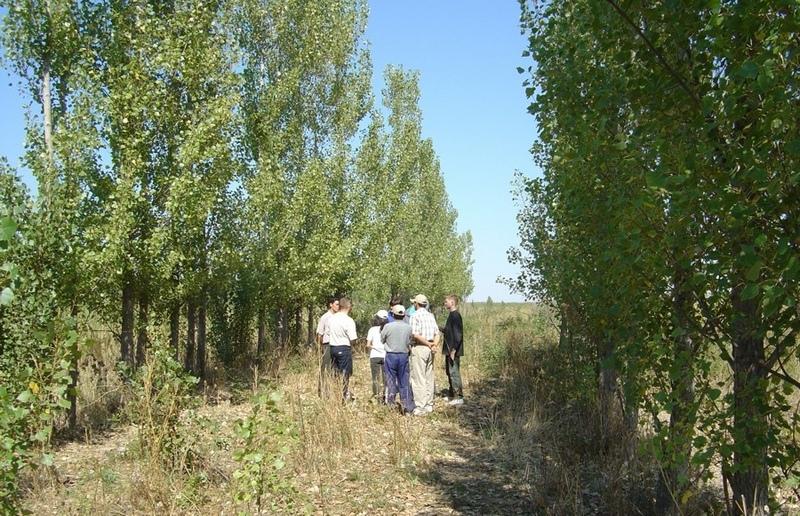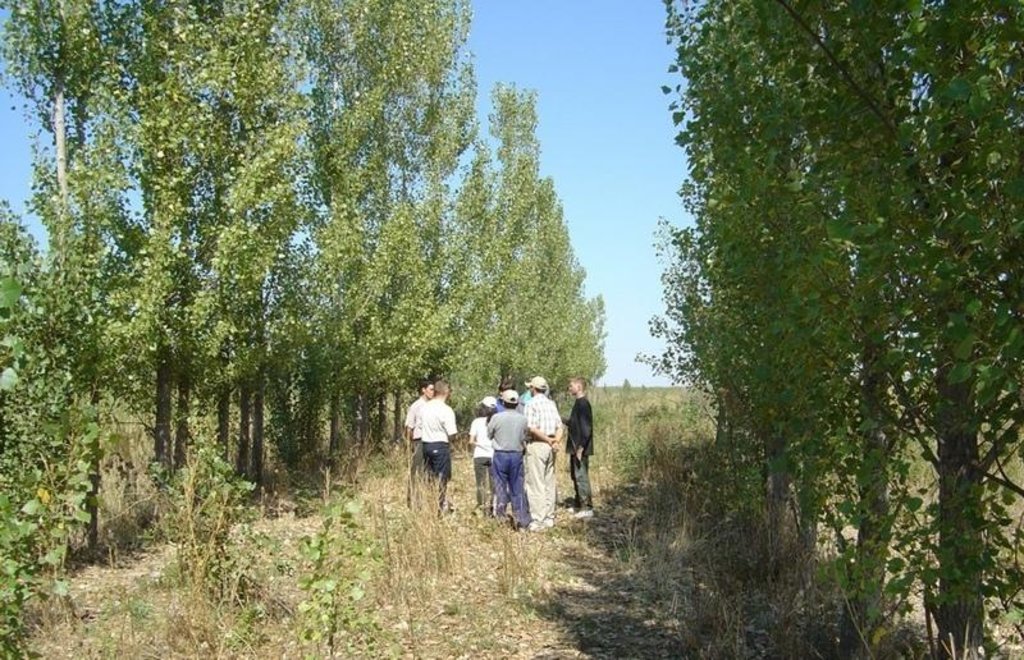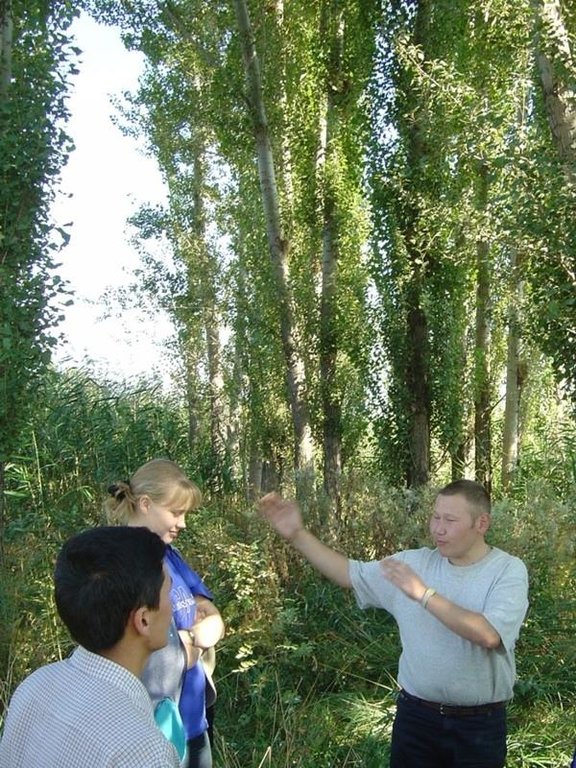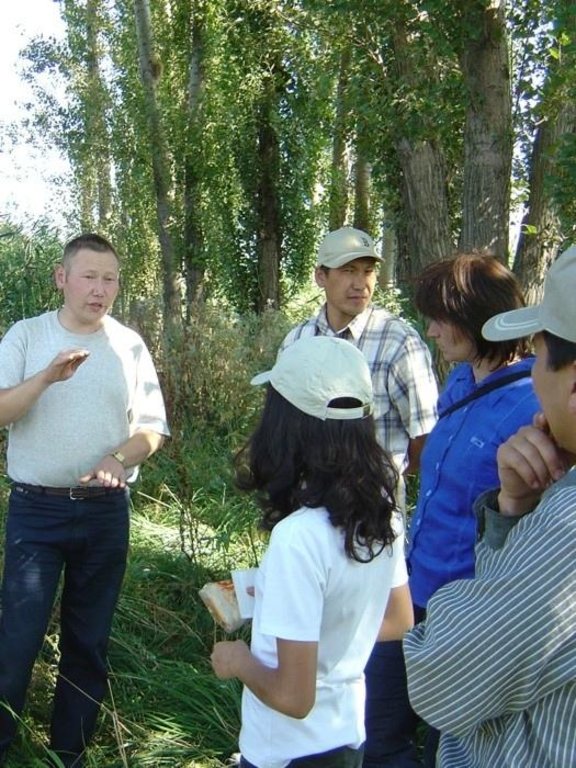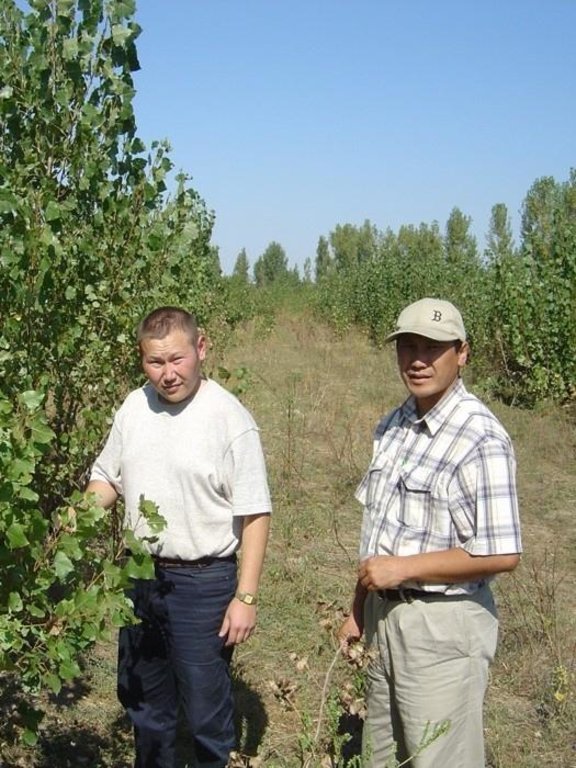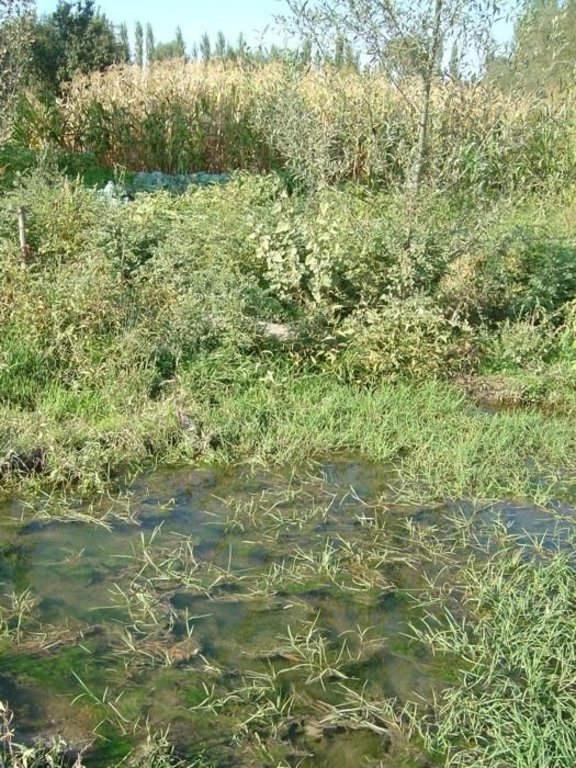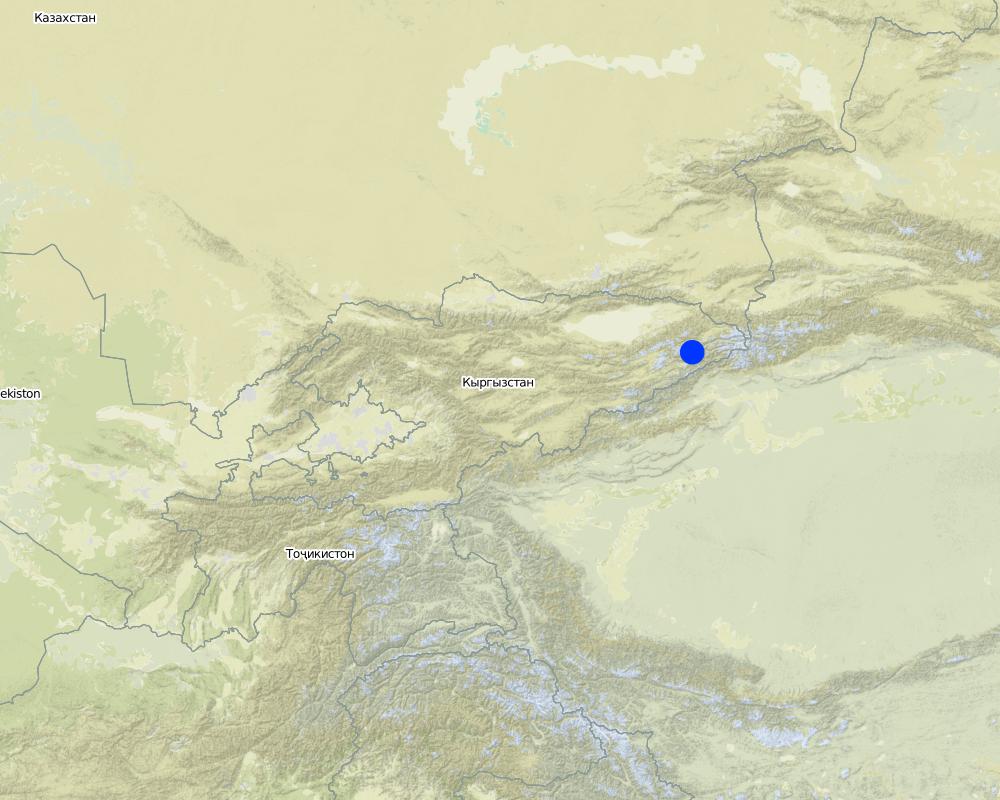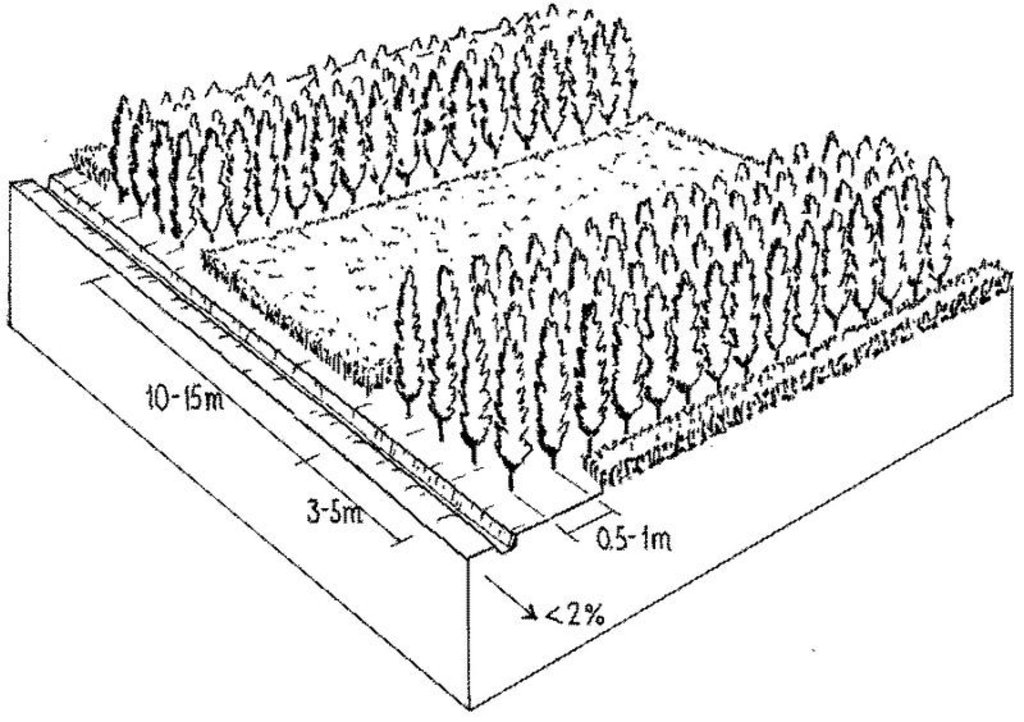Poplar trees for bio-drainage [Kirghizistan]
- Création :
- Mise à jour :
- Compilateur : Abdybek Asanaliev
- Rédacteur : –
- Examinateurs : David Streiff, Deborah Niggli, Alexandra Gavilano
bio-drainage, reduce salinity, favourable microclimate for for plant growth
technologies_1098 - Kirghizistan
Voir les sections
Développer tout Réduire tout1. Informations générales
1.2 Coordonnées des personnes-ressources et des institutions impliquées dans l'évaluation et la documentation de la Technologie
Spécialiste GDT:
Nom du projet qui a facilité la documentation/ l'évaluation de la Technologie (si pertinent)
Book project: where the land is greener - Case Studies and Analysis of Soil and Water Conservation Initiatives Worldwide (where the land is greener)Nom du ou des institutions qui ont facilité la documentation/ l'évaluation de la Technologie (si pertinent)
Kyrgyz Agrarian University (Kyrgyz Agrarian University) - Kirghizistan1.3 Conditions relatives à l'utilisation par WOCAT des données documentées
Le compilateur et la(les) personne(s) ressource(s) acceptent les conditions relatives à l'utilisation par WOCAT des données documentées:
Oui
2. Description de la Technologie de GDT
2.1 Courte description de la Technologie
Définition de la Technologie:
Poplars planted to lower the ground water table and reduce salinity where irrigation drainage systems have broken down; lucerne cultivated between the tree lines.
2.2 Description détaillée de la Technologie
Description:
In irrigated areas of Central Asia, the drainage system introduced during soviet times has broken down due to lack of maintenance. As a result, water tables have been rising and soil salinity increasing. In the Chui Valley, which is the main crop production area in Kyrgyzstan, approximately 90% of the cultivated land is irrigated for wheat, maize, sugar beet, lucerne and vegetables. Of this, approximately one third (ca. 320,000 ha) is degraded due to loss of fertility, salinisation and waterlogging.
The individual initiative described here - poplar planting - has been applied on a degraded plain (about 400 m a.s.l.), under semi-arid conditions on a plot of 5 hectares. Though initially planted for timber, an important side effect was noted by the farmer in question. Poplar trees, well known for their tolerance to waterlogging and salinity, provide ‘bio-drainage’. Excess water is rapidly taken up by the root system and transpired through the dense foliage. Within the plantation the humidity level of the lower layers of air is increased, thus reducing the influence of the dry, hot winds. A more favourable microclimate for plant growth is thus created. Simultaneously the original purpose of planting - to obtain cheap timber and firewood - is achieved through the rapid growth of the trees: there is a severe shortage of wood locally.
The varieties used include the local Populus alba and Populus nigra as well as a hybrid from Kazakhstan, P. pyramidalis. The trees are planted in rows about 5 metres wide, separated by 10-15 metre strips planted with Medicago sativa (lucerne) and Bromus inermis (a grass), both of which are grown for hay (see technical drawing). Around 3,000 saplings are needed per hectare. The young poplars require irrigating during the first year before their roots can reach the water table. The trees are weeded and their lower branches pruned to encourage straight and fast growth. They are thinned twice before they are 14 years old: these thinnings can be sold. The poplars then remain until they are 20-25 years old and suitable for felling. The output of commercial timber of a poplar plantation is 3,000 m2 per hectare (1 m2 per mature tree). Slow-growing/sick trees, as well as pruned branches, are used as firewood - which can amount to 20-30 m3 per hectare. The cycle begins again after approximately 10 years, when new saplings are planted between the existing, thinned, lines of poplars. Desalinisation of the soil takes 10 years or a little longer, when it again becomes suitable for irrigated cereal cropping.
2.3 Photos de la Technologie
2.5 Pays/ région/ lieux où la Technologie a été appliquée et qui sont couverts par cette évaluation
Pays:
Kirghizistan
Région/ Etat/ Province:
Besh-Terek, Chui valley,
Spécifiez la diffusion de la Technologie:
- répartie uniformément sur une zone
Si la Technologie est uniformément répartie sur une zone, précisez la superficie couverte (en km2):
0,05
Commentaires:
Total area covered by the SLM Technology is 0.05 km2.
Map
×2.7 Introduction de la Technologie
Spécifiez comment la Technologie a été introduite: :
- au cours d'expérimentations / de recherches
3. Classification de la Technologie de GDT
3.1 Principal(aux) objectif(s) de la Technologie
- réduire, prévenir, restaurer les terres dégradées
3.2 Type(s) actuel(s) d'utilisation des terres, là où la Technologie est appliquée
Les divers types d'utilisation des terres au sein du même unité de terrain: :
Oui
Précisez l'utilisation mixte des terres (cultures/ pâturages/ arbres):
- Agroforesterie

Terres cultivées
- Cultures annuelles
Cultures annuelles - Précisez les cultures:
- cultures fourragères - luzerne
Nombre de période de croissance par an: :
- 1
Précisez:
Longest growing period in days: 180; Longest growing period from month to month: Mar - Sep

Forêts/ bois
Type d’arbres:
- Espèces de Populus (peuplier)
Commentaires:
Major food crop: Poplar, lucerne (alfalfa), wheat
Major land use problems (compiler’s opinion): Irrigation drainage systems have deteriorated (silted up, choked with weeds and reeds) due to lack of maintenance. This has led to a raised water table, waterlogging and increased salinity, thus seriously affecting productivity and making cultivation of some crops impossible. Farmers’ incomes have significantly reduced as a result.
Constraints of wastelands / deserts / glaciers / swamps
3.5 Groupe de GDT auquel appartient la Technologie
- gestion des plantations forestières
- Amélioration de la couverture végétale/ du sol
3.6 Mesures de GDT constituant la Technologie

pratiques agronomiques
- A1: Couverture végétale/ du sol

pratiques végétales
- V1: Couverture d’arbres et d’arbustes
Commentaires:
Type of agronomic measures: legume inter-planting
Type of vegetative measures: aligned: -against wind
3.7 Principaux types de dégradation des terres traités par la Technologie

dégradation chimique des sols
- Cn: baisse de la fertilité des sols et réduction du niveau de matière organique (non causée par l’érosion)
- Cs: salinisation/ alcalinisation

dégradation physique des sols
- Pw: saturation en eau des sols
Commentaires:
Secondary types of degradation addressed: Cn: fertility decline and reduced organic matter content
3.8 Prévention, réduction de la dégradation ou réhabilitation des terres dégradées
Spécifiez l'objectif de la Technologie au regard de la dégradation des terres:
- restaurer/ réhabiliter des terres sévèrement dégradées
4. Spécifications techniques, activités, intrants et coûts de mise en œuvre
4.1 Dessin technique de la Technologie
Spécifications techniques (associées au dessin technique):
Alternating strips of poplar trees for bio-drainage, and lucerne for fodder. Drainage channels (left) are spaced at 50 metres apart.
Technical knowledge required for field staff / advisors: moderate
Technical knowledge required for land users: moderate
Main technical functions: lower ground water level, decrease waterlogging & improve soil fertility, reduce risk of salinisation
Secondary technical functions: reduction in wind speed, increased air humidity & cooling effect
Aligned: -against wind
Vegetative material: T : trees / shrubs
Trees/ shrubs species: Poplars (Populus alba, Populus nigra, P.pyramidalis)
Auteur:
Mats Gurtner
4.2 Informations générales sur le calcul des intrants et des coûts
Indiquez la monnaie utilisée pour le calcul des coûts:
- dollars américains
4.3 Activités de mise en place/ d'établissement
| Activité | Calendrier des activités (saisonnier) | |
|---|---|---|
| 1. | Set up tree nursery one year before planting: take cuttings about | |
| 2. | Demarcate lines in field. | |
| 3. | Dig drainage trenches in the marshy area (50 cm deep, 50 cm wide, | (end of summer, early autumn) |
| 4. | Plough where seedlings of the poplars are to be planted. | |
| 5. | Transplant tree seedlings from the nursery to the field . | in spring |
| 6. | Irrigate the seedlings by furrow for one year. | |
| 7. | Protect the area from animals. | |
| 8. | Plant lucerne . | in first year after planting of poplars |
4.4 Coûts et intrants nécessaires à la mise en place
| Spécifiez les intrants | Unité | Quantité | Coûts par unité | Coût total par intrant | % du coût supporté par les exploitants des terres | |
|---|---|---|---|---|---|---|
| Main d'œuvre | All the Labour | ha | 1,0 | 350,0 | 350,0 | 100,0 |
| Main d'œuvre | Machine use | ha | 1,0 | 100,0 | 100,0 | 100,0 |
| Main d'œuvre | Animal traction | ha | 1,0 | 5,0 | 5,0 | 100,0 |
| Equipements | Tools | ha | 1,0 | 15,0 | 15,0 | |
| Matériel végétal | Seeds | ha | 1,0 | 20,0 | 20,0 | 1,0 |
| Matériel végétal | Seedlings | ha | 1,0 | 350,0 | 350,0 | 1,0 |
| Matériel végétal | Nursery | ha | 1,0 | 80,0 | 80,0 | 1,0 |
| Coût total de mise en place de la Technologie | 920,0 | |||||
| Coût total de mise en place de la Technologie en dollars américains (USD) | 920,0 | |||||
Commentaires:
Duration of establishment phase: 24 month(s)
4.5 Activités d'entretien/ récurrentes
| Activité | Calendrier/ fréquence | |
|---|---|---|
| 1. | Prune lower branches of the trees to encourage tall and straight | |
| 2. | Continue protection of the plot (because of lucerne). | |
| 3. | Cut lucerne for hay . | /4 times per year |
| 4. | Weed control (main weeds are Chenopodium album, |
4.6 Coûts et intrants nécessaires aux activités d'entretien/ récurrentes (par an)
| Spécifiez les intrants | Unité | Quantité | Coûts par unité | Coût total par intrant | % du coût supporté par les exploitants des terres | |
|---|---|---|---|---|---|---|
| Main d'œuvre | All the labour | ha | 1,0 | 25,0 | 25,0 | 100,0 |
| Equipements | Machine use | ha | 1,0 | 5,0 | 5,0 | 100,0 |
| Coût total d'entretien de la Technologie | 30,0 | |||||
| Coût total d'entretien de la Technologie en dollars américains (USD) | 30,0 | |||||
Commentaires:
Machinery/ tools: shovel, axe, saw
Labour for establishment and maintenance are provided by the farmer and his family. After 10–15 years trees are
thinned for timber and the cycle begins again – with reduced establishment costs: new saplings are planted between the
existing, thinned, lines of poplars. On two sides the plot is protected by a drainage ditch and a concrete canal protect the plot respectively. Furthermore, there is an agreement with the neighbours not to let the animals graze the lucerne. However after the last cut of lucerne animals are allowed to graze the plot.
5. Environnement naturel et humain
5.1 Climat
Précipitations annuelles
- < 250 mm
- 251-500 mm
- 501-750 mm
- 751-1000 mm
- 1001-1500 mm
- 1501-2000 mm
- 2001-3000 mm
- 3001-4000 mm
- > 4000 mm
Zone agro-climatique
- semi-aride
5.2 Topographie
Pentes moyennes:
- plat (0-2 %)
- faible (3-5%)
- modéré (6-10%)
- onduleux (11-15%)
- vallonné (16-30%)
- raide (31-60%)
- très raide (>60%)
Reliefs:
- plateaux/ plaines
- crêtes
- flancs/ pentes de montagne
- flancs/ pentes de colline
- piémonts/ glacis (bas de pente)
- fonds de vallée/bas-fonds
Zones altitudinales:
- 0-100 m
- 101-500 m
- 501-1000 m
- 1001-1500 m
- 1501-2000 m
- 2001-2500 m
- 2501-3000 m
- 3001-4000 m
- > 4000 m
5.3 Sols
Profondeur moyenne du sol:
- très superficiel (0-20 cm)
- superficiel (21-50 cm)
- modérément profond (51-80 cm)
- profond (81-120 cm)
- très profond (>120 cm)
Texture du sol (de la couche arable):
- moyen (limoneux)
Matière organique de la couche arable:
- moyen (1-3%)
Si disponible, joignez une description complète du sol ou précisez les informations disponibles, par ex., type de sol, pH/ acidité du sol, capacité d'échange cationique, azote, salinité, etc.
Soil fertility is very low - low
Soil drainage / infiltration is poor
5.6 Caractéristiques des exploitants des terres appliquant la Technologie
Orientation du système de production:
- subsistance (auto-approvisionnement)
- commercial/ de marché
Revenus hors exploitation:
- 10-50% de tous les revenus
Indiquez toute autre caractéristique pertinente des exploitants des terres:
Off-farm income specification: this individual is an employee of the regional agricultural department and has a small business
Market orientation of production system: Thinned poplar saplings, timber and firewood from prunings for market
5.7 Superficie moyenne des terres utilisées par les exploitants des terres appliquant la Technologie
- < 0,5 ha
- 0,5-1 ha
- 1-2 ha
- 2-5 ha
- 5-15 ha
- 15-50 ha
- 50-100 ha
- 100-500 ha
- 500-1 000 ha
- 1 000-10 000 ha
- > 10 000 ha
5.8 Propriété foncière, droits d’utilisation des terres et de l'eau
Propriété foncière:
- individu, avec titre de propriété
Droits d’utilisation des terres:
- individuel
6. Impacts et conclusions
6.1 Impacts sur site que la Technologie a montrés
Impacts socio-économiques
Production
production fourragère
Commentaires/ spécifiez:
Lucerne between tree lines
qualité des fourrages
Commentaires/ spécifiez:
Lucerne between tree lines
production de bois
Revenus et coûts
revenus agricoles
charge de travail
Autres impacts socio-économiques
input contstraints
Commentaires/ spécifiez:
Not all the farmers have enough resources for introduction of this technology (equipment,
main benefit
Commentaires/ spécifiez:
However, short-term benefit from lucerne as fodder and from firewood through pruning
Impacts socioculturels
connaissances sur la GDT/ dégradation des terres
Impacts écologiques
Cycle de l'eau/ ruissellement
drainage de l'excès d'eau
Sols
humidité du sol
Réduction des risques de catastrophe et des risques climatiques
risques d'incendies
vitesse du vent
Autres impacts écologiques
soil fertility
Commentaires/ spécifiez:
Due to lucerne: 100–130 kg of N
biodiversity
6.2 Impacts hors site que la Technologie a montrés
sédiments (indésirables) transportés par le vent
General drop of water table
6.4 Analyse coûts-bénéfices
Quels sont les bénéfices comparativement aux coûts de mise en place (du point de vue des exploitants des terres)?
Rentabilité à court terme:
négative
Rentabilité à long terme:
très positive
Quels sont les bénéfices comparativement aux coûts d'entretien récurrents (du point de vue des exploitants des terres)?
Rentabilité à court terme:
positive
Rentabilité à long terme:
très positive
6.5 Adoption de la Technologie
- cas isolés/ expérimentaux
Si disponible, quantifiez (nombre de ménages et/ou superficie couverte):
1 household
De tous ceux qui ont adopté la Technologie, combien d'entre eux l'ont fait spontanément, à savoir sans recevoir aucune incitation matérielle, ou aucune rémunération? :
- 0-10%
Commentaires:
There is a little trend towards spontaneous adoption of the Technology
Comments on adoption trend: A single farmer has developed this technology. It should be possible to spread the technology among other farmers but financial support (eg interest-free credit) will need to be provided. A recent assessment has showed that there is growing interest in the system by farmers in the region. Additionally, in the lower Yanvan Valley of Tajikistan, a similar bio-drainage system has been described - using poplars and mulberry trees. In that situation wheat is planted in association with the trees.
6.7 Points forts/ avantages/ possibilités de la Technologie
| Points forts/ avantages/ possibilités du point de vue du compilateur ou d'une autre personne ressource clé |
|---|
|
Positive ecological effect: salinity and area of marshy land can be reduced and waterlogged soils reclaimed How can they be sustained / enhanced? Awareness raising and training of farmers to show the effect of poplar trees on reduction of waterlogging and salinisation. |
|
Rapid benefit through the production of lucerne and grass. Long-term production of valuable firewood and timber (both are in short supply) How can they be sustained / enhanced? Show the economic benefits of additional lucerne production and timber and firewood; demonstrate marketing opportunities. |
6.8 Faiblesses/ inconvénients/ risques de la Technologie et moyens de les surmonter
| Faiblesses/ inconvénients/ risques du point de vue du compilateur ou d'une autre personne ressource clé | Comment peuvent-ils être surmontés? |
|---|---|
| The implementation of the technology is not possible for all land users due to input and labour constraints |
Financial support, better organisation/ share of equipment. |
| Major benefit from timber production comes only after 25 years |
Create awareness about additional short-term benefits, especially firewood and fodder, as well as the long-term effects and the sustainability of the system. |
|
Cannot be replicated by all farmers in the valley at the same density as the market for trees (timber, firewood) will be saturated, and trees can never completely take the place of irrigated food crops: nevertheless the benefits will extend to those growers through the drainage function of the poplars |
A new overall production system will have to be worked out for the region. |
|
The case reported here works in its current design because of its isolated ‘island effect’: if more farmer grew poplar, the same bio-drainage effect could be achieved over the whole valley at a lower density of trees per unit area, implying a larger proportion of cultivable land. |
7. Références et liens
7.1 Méthodes/ sources d'information
7.2 Références des publications disponibles
Titre, auteur, année, ISBN:
Budaychiev D (2002) The prospects for hybrid poplar forest plantations. Resolving problems and the strategy of reformingagrarian science. News of Kyrgyz Agrarian Academy Vol. 2, Issue 3, 4.1 Bishkek
Liens et modules
Développer tout Réduire toutLiens
Aucun lien
Modules
Aucun module trouvé


